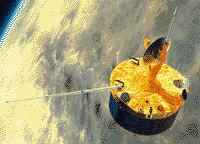Pioneer 12
Pioneer Venus Orbiter
Part of the Pioneer program
 Pioneer Venus Orbiter was designed to perform long-term observations of the Venusian atmosphere and surface features. After entering orbit around Venus in 1978, the spacecraft returned global maps of the planet's clouds, atmosphere and ionosphere, measurements of the atmosphere-solar wind interaction, and radar maps of 93 percent of the planet's surface. Additionally, the vehicle made use of several opportunities to make systematic UV observations of several comets. With a planned primary mission duration of only eight months, the spacecraft remained in operation until October 8, 1992 when it finally burned up in Venus' atmosphere after running out of propellant.
Data from the Orbiter was correlated with data from its sister vehicle (Pioneer Venus Multiprobe and its atmospheric probes) to relate specific local measurements to the general state of the planet and its environment as observed from orbit.
Pioneer Venus Orbiter was designed to perform long-term observations of the Venusian atmosphere and surface features. After entering orbit around Venus in 1978, the spacecraft returned global maps of the planet's clouds, atmosphere and ionosphere, measurements of the atmosphere-solar wind interaction, and radar maps of 93 percent of the planet's surface. Additionally, the vehicle made use of several opportunities to make systematic UV observations of several comets. With a planned primary mission duration of only eight months, the spacecraft remained in operation until October 8, 1992 when it finally burned up in Venus' atmosphere after running out of propellant.
Data from the Orbiter was correlated with data from its sister vehicle (Pioneer Venus Multiprobe and its atmospheric probes) to relate specific local measurements to the general state of the planet and its environment as observed from orbit.
Despite their drastically different roles, the Orbiter and Multiprobe were very similar in design. The use of identical systems (including flight hardware, flight software, and ground test equipment) and incorporation of existing designs from previous missions (including OSO and Intelsat) allowed the mission to meet its objectives at minimum cost.
Spacecraft
Spin stabilized at ~15 rpm. Body mounted solar panels provided 312 W. 2 7.5 Ah NiCd batteries. A 1.09 m despun dish antenna used for high rate S-band communication with Earth, with low-gain omni antennas for emergency communication. 4 10W TWTAs. An X-band transmitter also incorporated for occultation measurements. Attitude determination provided by sun sensors and star sensors. Nutation damping performed with a partially filled tube of liquid Freon. Hydrazine propellant system with 7 thrusters used for attitude control and orbit adjustment. A solid rocket motor providing 18,000 N of thrust used for Venus orbit insertion. 4.8 m deployable boom for the magnetometer.
Payload
Pioneer Venus Orbiter carried 17 experiments (with a total mass of 45
kg). Most of the instruments were still operating when the spacecraft entered the atmosphere:
Cloud photopolarimeter - measured the vertical distribution of the
clouds
Surface radar mapper - mapped planetary topography and surface
characteristics
Infrared radiometer - monitored IR emissions from the Venusian atmosphere
Airglow ultraviolet spectrometer - measured scattered and emitted UV radiation
Neutral mass spectrometer - evaluated the composition of the upper atmosphere
Solar wind plasma analyzer - measured properties of the solar wind
Magnetometer - examined Venus' magnetic field
Electric field detector - studied the solar wind and its interactions with the Venusian atmosphere
Electron temperature probe - examined the thermal properties of Venus' ionosphere
Ion mass spectrometer - measured the ionospheric ion population
Charged particle retarding potential analyzer - Studied ionospheric particles
2 radio science experiments - mapped Venus' gravity field
Radio occultation experiment - helped characterize the atmosphere
Atmospheric drag experiment - upper atmosphere density measurements
Radio science atmospheric and solar wind turbulence experiment
Gamma ray burst detector - monitored gamma ray burst events
| Country of Origin | United States |
| Customer/User | NASA, Ames Research Center |
| Manufacturer(s) | Hughes |
| Size | Cylinder: 2.5 m dia. x 1.2 m tall |
| Orbit | Venus direct trajectory. Venus orbit insertion December 4, 1978. 66000 x 150 km (nominal), incl. = 105 deg. Orbital period = 23 hours 11 minutes |
| Design Life | 1.5 years |
| Related Sites | Pioneer Home Page |
Launch Facts
| Name | Int'l Desig. | Date | Site | Vehicle | Orbit | Mass(kg) |
| Notes | ||||||
| Pioneer 12 | 1978-051A | 5/20/78 | ESMC | Atlas Centaur | Venus | 582 |
| Venus orbiter | ||||||
Information in The Mission and Spacecraft Library is provided without warranty or guarantee. USE AT YOUR OWN RISK.